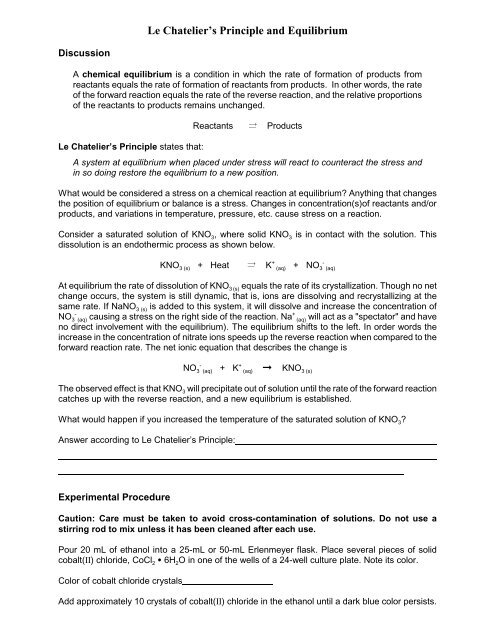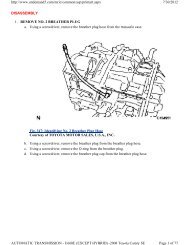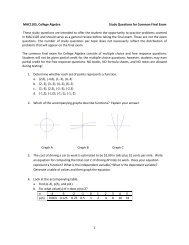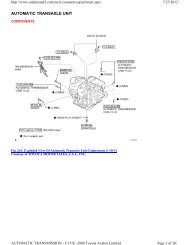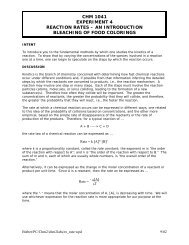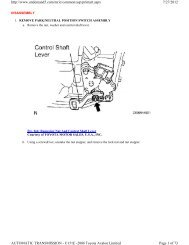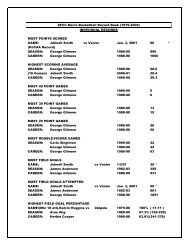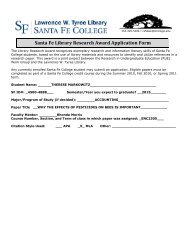Le Chatelier's Principle and Equilibrium - Santa Fe College
Le Chatelier's Principle and Equilibrium - Santa Fe College
Le Chatelier's Principle and Equilibrium - Santa Fe College
Create successful ePaper yourself
Turn your PDF publications into a flip-book with our unique Google optimized e-Paper software.
Discussion<br />
<strong>Le</strong> Chatelier’s <strong>Principle</strong> <strong>and</strong> <strong>Equilibrium</strong><br />
A chemical equilibrium is a condition in which the rate of formation of products from<br />
reactants equals the rate of formation of reactants from products. In other words, the rate<br />
of the forward reaction equals the rate of the reverse reaction, <strong>and</strong> the relative proportions<br />
of the reactants to products remains unchanged.<br />
Reactants Products<br />
<strong>Le</strong> Chatelier’s <strong>Principle</strong> states that:<br />
A system at equilibrium when placed under stress will react to counteract the stress <strong>and</strong><br />
in so doing restore the equilibrium to a new position.<br />
What would be considered a stress on a chemical reaction at equilibrium? Anything that changes<br />
the position of equilibrium or balance is a stress. Changes in concentration(s)of reactants <strong>and</strong>/or<br />
products, <strong>and</strong> variations in temperature, pressure, etc. cause stress on a reaction.<br />
Consider a saturated solution of KNO 3, where solid KNO 3 is in contact with the solution. This<br />
dissolution is an endothermic process as shown below.<br />
KNO3 (s) + Heat K +<br />
-<br />
(aq) + NO3 (aq)<br />
At equilibrium the rate of dissolution of KNO 3 (s) equals the rate of its crystallization. Though no net<br />
change occurs, the system is still dynamic, that is, ions are dissolving <strong>and</strong> recrystallizing at the<br />
same rate. If NaNO 3 (s) is added to this system, it will dissolve <strong>and</strong> increase the concentration of<br />
-<br />
NO3 (aq) causing a stress on the right side of the reaction. Na +<br />
(aq) will act as a "spectator" <strong>and</strong> have<br />
no direct involvement with the equilibrium). The equilibrium shifts to the left. In order words the<br />
increase in the concentration of nitrate ions speeds up the reverse reaction when compared to the<br />
forward reaction rate. The net ionic equation that describes the change is<br />
-<br />
NO3 (aq) + K +<br />
(aq) KNO3 (s)<br />
The observed effect is that KNO 3 will precipitate out of solution until the rate of the forward reaction<br />
catches up with the reverse reaction, <strong>and</strong> a new equilibrium is established.<br />
What would happen if you increased the temperature of the saturated solution of KNO 3?<br />
Answer according to <strong>Le</strong> Chatelier’s <strong>Principle</strong>:<br />
Experimental Procedure<br />
Caution: Care must be taken to avoid cross-contamination of solutions. Do not use a<br />
stirring rod to mix unless it has been cleaned after each use.<br />
Pour 20 mL of ethanol into a 25-mL or 50-mL Erlenmeyer flask. Place several pieces of solid<br />
cobalt(II) chloride, CoCl 2 ` 6H 2O in one of the wells of a 24-well culture plate. Note its color.<br />
Color of cobalt chloride crystals<br />
Add approximately 10 crystals of cobalt(II) chloride in the ethanol until a dark blue color persists.
Write the net equation that describes the observed change:<br />
Write the net equation that describes the observed change:<br />
Write the net equation that describes the observed change:<br />
2<br />
Add more crystals if needed. Stir until all the crystals have dissolved. Transfer 2-mL of the blue<br />
solution to each of four wells in the culture plate(1 mL is approximately 20 drops). Be sure to leave<br />
a small amount of solution in the beaker. Place a white paper underneath the culture plate <strong>and</strong><br />
label each filled well by writing #1,2,3 <strong>and</strong> 4 on the paper above each well.<br />
Once dissolved the following equilibrium is established. It involves two complex ions, hexaaquo<br />
cobalt(II) <strong>and</strong> tetrachloro cobaltate(II):<br />
2+ -<br />
Co(H2O) 6 + 4Cl<br />
pink<br />
2- CoCl4 + 6H2O<br />
blue<br />
hexaaquo cobalt(II) tetrachloro cobaltate(II)<br />
Which side, reactants or products, is favored at equilibrium? How do you know?<br />
To well #1 add 5 drops of deionized water, one drop at a time. Stir. Record you observations.<br />
Well #1 Observations:<br />
Repeat this step for well #2 so that they both exhibit the same color. Use well #4 as a st<strong>and</strong>ard for<br />
comparison purposes.<br />
Carefully add one drop of 12 M HCl at a time to well #1 until five drops have been added <strong>and</strong> stir.<br />
Caution: 12 M HCl is caustic <strong>and</strong> corrosive. Avoid contact <strong>and</strong> immediately rinse all spills<br />
with lots of water.<br />
Well #1 + HCl(aq) Observations:<br />
Comment on the difference in the intensity or hue of the color <strong>and</strong> its relationship to the equilibrium.<br />
To well #2 add a 2-3 spatula tips (approximately 0.06-0.07 g) of granular anhydrous calcium<br />
chloride <strong>and</strong> stir. You should observe a change.<br />
Well #2 + CaCl 2 Observations:
Write the net equation(s) that describes the observed change:<br />
Write the net equation that describes the observed change (be sure to include heat<br />
term):<br />
Write the net equation that describes the observed change change(be sure to include<br />
heat term):<br />
3<br />
To well #3 add 10 drops of 0.1 M silver nitrate, AgNO 3. Caution: Silver Nitrate will stain clothing<br />
<strong>and</strong> skin.<br />
Well #3 + AgNO 3(aq) Observations:<br />
What is the precipitate formed?<br />
(If you do not know, find out by checking a solubility table in your textbook.)<br />
To the remaining solution in the flask add enough deionized water dropwise until a purple color is<br />
achieved that is half-way between blue <strong>and</strong> pink. Place the beaker on a hot plate <strong>and</strong> warm until<br />
a color change appears. Record your observations.<br />
Observations:<br />
Chill the beaker in an ice bath for several minutes <strong>and</strong> again record observations.<br />
Observations:<br />
Explain the color changes that resulted from heating or cooling. Is the original equilibrium reaction<br />
exothermic or endothermic? Where would heat go in<br />
2+ - 2-<br />
Co(H2O) 6 + 4Cl CoCl4 + 6H2O<br />
Quantitative Analysis of Equilibria<br />
You will calculate the K eq for the reaction between aqueous iron(III) nitrate, <strong>Fe</strong>(NO 3) 3 <strong>and</strong> potassium<br />
thiocyanate, KSCN. The reaction forms a red-orange complex, <strong>Fe</strong>SCN 2+ . The net-ionic equation<br />
is shown below.<br />
<strong>Fe</strong> 3+<br />
(aq) + SCN -<br />
(aq)<br />
<strong>Fe</strong>SCN 2+<br />
(aq)
The equilibrium constant<br />
for this reaction is:<br />
yellow-orange red-orange<br />
4<br />
In order to find the equilibrium concentration a spectrometer will be used. Since a colored complex<br />
is formed, the concentration of <strong>Fe</strong>SCN 2+ can be determined by measuring the absorbance. The<br />
amount of light absorbed by the sample is proportional to the concentration of <strong>Fe</strong>SCN 2+ .<br />
For our experiment the constant is 5.00 x 10 3 .<br />
[<strong>Fe</strong>SCN 2+ ] = Absorbance/constant<br />
To reduce the probability of large errors you will determine K eq three times for different initial<br />
concentrations .<br />
Experimental<br />
Label three 25 ml flasks 1,2 <strong>and</strong> 3. Obtain approximately 15 mL of the 2.00 x 10 -3 M <strong>Fe</strong>(NO 3) 3<br />
solution from the stock bottle <strong>and</strong> place in a properly labeled flask. Also obtain approximately 10<br />
mL of 2.00 x 10 -3 M KSCN samples <strong>and</strong> place in a properly labeled flask. Using a 10-mL graduated<br />
pipet, transfer the indicated volumes of 0.00200 M <strong>Fe</strong>(NO 3) 3 into each of three small flasks. Be<br />
sure to rinse the pipet with deionized water <strong>and</strong> a sample of the next solution before each<br />
transfer. Add the required amounts of 1.00M HNO 3 <strong>and</strong> deionized water in each flask. Do not add<br />
the KSCN solution until you are ready to measure the absorbance for each flask.<br />
Flask mL of 0.00200M<br />
<strong>Fe</strong>(NO 3) 3 in 1.00M HNO 3<br />
mL of 1.00M HNO 3 mL of d.i. water mL of KSCN<br />
0.00200 M<br />
1 4.50 0.50 3.50 1.50<br />
2 3.00 2.00 3.50 1.50<br />
3 1.50 3.50 2.00 3.00<br />
Volumes will be additive for a total volume of 10.00 mL of solution. Stir each solution well before<br />
poring into a cuvette.<br />
Place a portion of each solution in a spectrophotometer cell <strong>and</strong> measure the absorbance to three<br />
significant figures if possible at a wavelength of 447nm (preset). Record the values.<br />
Test tube 1<br />
Absorbance [<strong>Fe</strong>SCN 2+ ] (calculated) M
Test tube 2<br />
Test tube 3<br />
5<br />
Set up your equilibrium calculations just as if you were doing an equilibrium problem in class. You<br />
can attach an extra page with your calculations. Remember molarity = moles/volume(L). Note that<br />
the initial volume of reactants is different from the final volume at equilibrium. Be sure to correct<br />
for this as you calculate the initial concentrations. Note that in each of the test tubes : the moles<br />
of <strong>Fe</strong> 3+ reacted = moles of <strong>Fe</strong>SCN 2+ at equilibrium.<br />
Test Tube 1 Calculations:<br />
initial<br />
concentrations<br />
(corrected to total<br />
volume)<br />
change in<br />
concentrations<br />
equilibrium<br />
concentrations<br />
Test Tube 2 Calculations:<br />
initial<br />
concentrations<br />
(corrected to total<br />
volume)<br />
change in<br />
concentrations<br />
equilibrium<br />
concentrations<br />
Test Tube 3 Calculations:<br />
<strong>Fe</strong> 3+ (aq)+SCN - (aq) <strong>Fe</strong>SCN 2+ (aq)<br />
[<strong>Fe</strong> 3+ ] [SCN - ] [ <strong>Fe</strong>SCN 2+ ]<br />
[<strong>Fe</strong> 3+ ] [SCN - ] [ <strong>Fe</strong>SCN 2+ ]<br />
[<strong>Fe</strong> 3+ ] [SCN - ] [ <strong>Fe</strong>SCN 2+ ]
initial<br />
concentrations<br />
(corrected to total<br />
volume)<br />
change in<br />
concentrations<br />
equilibrium<br />
concentrations<br />
K eq (test tube 1)<br />
K eq (test tube 2)<br />
K eq (test tube 3)<br />
K eq = ± (Average ± average deviation)<br />
Show setup below:<br />
Post-Lab Questions:<br />
1. Suppose you have P 2 (g) in a sealed flask. At a constant temperature the following<br />
6
equilibrium takes place<br />
P 4 (g) Ø 2 P 2 (g)<br />
a. What is the value of Q for the equilibrium as written?<br />
b. In which direction will the reaction proceed?<br />
c. Is K p greater, lesser or equal to K eq ?<br />
Once equilibrium is attained you decide to do the following changes. In which direction will the<br />
equilibrium shift if you:<br />
d. add P 4 (g) at constant temperature<br />
e. increase the volume of the container at constant temperature<br />
f. increase the pressure of the system at constant temperature<br />
g. increase the temperature of the system at constant pressure<br />
2. Imagine yourself the size of atoms inside a beaker containing the equilibrium which you<br />
studied in this lab which has a K eq greater than one.<br />
2+ - 2-<br />
Co(H2O) 6 + 4Cl CoCl4 + 6H2O<br />
7<br />
Write a brief, nanoscale description of what you observe around you before <strong>and</strong> after the<br />
addition of more water to the mixture.<br />
3. The reaction of oxygen to produce ozone proceeds according to the reaction below <strong>and</strong> has<br />
an equilibrium constant of 6.3 x 10 -58 . The concentration of oxygen in air is about 9.4 x 10 -<br />
3 M. Determine the concentration of ozone in an equilibrium mixture.<br />
3O 2(g) 2O 3(g)


